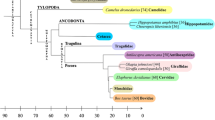Abstract
Many canine tumour types represent useful models for tumours also found in humans. Studies of chromosomal abnormalities in canine tumours have been impeded by the complexity of the canine karyotype (2n = 78), which has made accurate identification of rearranged chromosomes difficult and laborious. To overcome this difficulty we have developed a seven-colour paint system for canine chromosomes, with six sets of chromosome paints covering all chromosomes except Y. Several pairs of canine autosomes co-locate in the flow karyotype. To distinguish these autosomes from each other, paint sets were supplemented with chromosomes of red fox and Japanese raccoon dog. Paints were used in fluorescence in-situ hybridization to analyse karyotypes in fourteen canine soft tissue sarcomas. Rearranged karyotypes were observed in seven tumours, but there was evidence for loss of rearrangement during tissue culture. Five tumours had rearrangements involving four chromosomes or fewer; one, a chondrosarcoma, had lost seven chromosomes whilst the last, a spindle cell sarcoma, had rearrangements involving eighteen chromosome pairs. The paint sets described here facilitate the complete cytogenetic analysis of balanced translocations and other inter-chromosomal rearrangements in canine tumours. We believe that this is the first canine tumour series to be subjected to this level of analysis.
Similar content being viewed by others
References
Breen M, Bullerdiek J, Langford CF (1999a) The DAPI banded karyotype of the domestic dog (Canis familiaris) generated using chromosome-specific paint probes. Chromosome Res 7: 401–406.
Breen M, Thomas R, Binns MM, Carter NP, Langford CF (1999b) Reciprocal chromosome painting reveals detailed regions of conserved synteny between the karyotypes of the domestic dog (Canis familiaris) and human. Genomics 61: 145–155.
Breen M, Jouquand S, Renier C, et al. (2001) Chromosome-specific single-locus FISH probes allow anchorage of an 1800-marker integrated radiation-hybrid/linkage map of the domestic dog genome to all chromosomes. Genome Res 11: 1784–1795.
Dobson JM, Samuel S, Milstein H, Rogers K, Wood JL (2002) Canine neoplasia in the UK: estimates of incidence rates from a population of insured dogs. J Small Anim Pract 43: 240–246.
Dunn KA, Thomas R, Binns MM, Breen M (2000) Comparative genomic hybridization (CGH) in dogs — application to the study of a canine glial tumour cell line. Vet J 160: 77–82.
Graphodatsky AS, Yang F, O’Brien PC, et al. (2000) A comparative chromosome map of the Arctic fox, red fox and dog defined by chromosome painting and high resolution G-banding. Chromosome Res 8: 253–263.
Guyon R, Lorentzen TD, Hitte C, et al. (2003) A 1-Mb resolution radiation hybrid map of the canine genome. Proc Natl Acad Sci USA 100: 5296–5301.
Hendrick MJ, Mahaffey EA, Moore FM, Vos JH, Walder EJ (1998) Mesenchymal tumors of skin and soft tissues of domestic animals. WHO Histological Classification of Tumors of Domestic Animals. American Registry of Pathologists (pub).
Horsting N, Wohlsein P, Reimann N, Bartnitzke S, Bullerdiek J, Nolte I (1999) Cytogenetic analysis of three oropharyngeal malignant melanomas in dogs. Res Vet Sci 67: 149–151.
Langford CF, Fischer PE, Binns MM, Holmes NG, Carter NP (1996) Chromosome-specific paints from a high-resolution flow karyotype of the dog. Chromosome Res 4: 115–123.
Mayr B, Eschborn U, Loupal G, Schleger W (1993) Trisomy 1 in a canine mammary tubular adenocarcinoma, complex type. Vet Pathol 30: 311–313.
Mayr B, Dressler A, Reifinger M, Feil C (1998) Cytogenetic alterations in eight mammary tumors and tumor-suppressor gene p53 mutation in one mammary tumor from dogs. Am J Vet Res 59: 69–78.
Mitelman F, Johansson B, Mertens F, eds. (2004) Mitelman Database of Chromosome Aberrations in Cancer. http://cgap.nci.nih.gov/Chromosomes/Mitelman
Preister WA, McKay FW (1980) The occurrence of tumors in domestic animals. National Cancer Institutes Monograph 54: 178.
Reid T, Baldini A, Rand TC, Ward DC (1992) Simultaneous visualisation of 7 different probes by in-situ hybridisation using combinatorial fluorescence and digital image microscopy. Proc Natl Acad Sci USA 89: 1388–1392
Sargan DR, Yang F, Squire M, Milne BS, O’Brien PC, Ferguson-Smith MA (2000) Use of flow-sorted canine chromosomes in the assignment of canine linkage, radiation hybrid, and syntenic groups to chromosomes: refinement and verification of the comparative chromosome map for dog and human. Genomics 69: 182–195.
Telenius H, Pelmear AH, Tunnacliffe A, et al. (1992) Cytogenetic analysis by chromosome painting using DOP-PCR amplified flow-sorted chromosomes. Genes Chromosomes Cancer 4: 257–263.
Thomas R, Smith KC, Gould R, Gower SM, Binns MM, Breen M (2001) Molecular cytogenetic analysis of a novel high-grade canine T-lymphoblastic lymphoma demonstrating co-expression of CD3 and CD79a cell markers. Chromosome Res 9: 649–657.
Thomas R, Smith KC, Ostrander EA, Galibert F, Breen M (2003) Chromosome aberrations in canine multicentric lymphomas detected with comparative genomic hybridisation and a panel of single locus probes. Br J Cancer 89: 1530–1537.
Vail DM, MacEwen EG (2000) Spontaneously occurring tumors of companion animals as models for human cancer. Cancer Invest 18: 781–792.
Wayne RK, Geffen E, Girman DJ, Koepfli KP, Lau LM, Marshall CR (1997) Molecular systematics of the Canidae. Syst Biol 46: 622–653.
Withrow SJ, Powers BE, Straw RC, Wilkins RM (1991) Comparative aspects of osteosarcoma. Dog versus man. Clin Orthop 270: 159–168.
Yang F, O’Brien PC, Milne BS, et al. (1999) A complete comparative chromosome map for the dog, red fox, and human and its integration with canine genetic maps. Genomics 62: 189–202.
Author information
Authors and Affiliations
Corresponding author
Rights and permissions
About this article
Cite this article
Milne, B.S., Hoather, T., O’Brien, P.C. et al. Karyotype of canine soft tissue sarcomas: a multi-colour, multi-species approach to canine chromosome painting. Chromosome Res 12, 825–835 (2004). https://doi.org/10.1007/s10577-005-5542-9
Received:
Accepted:
Issue Date:
DOI: https://doi.org/10.1007/s10577-005-5542-9




